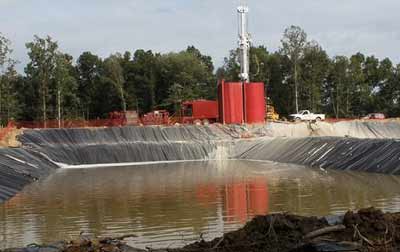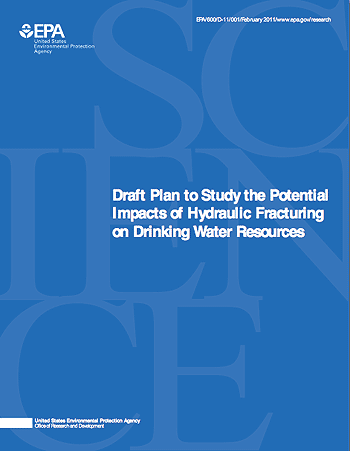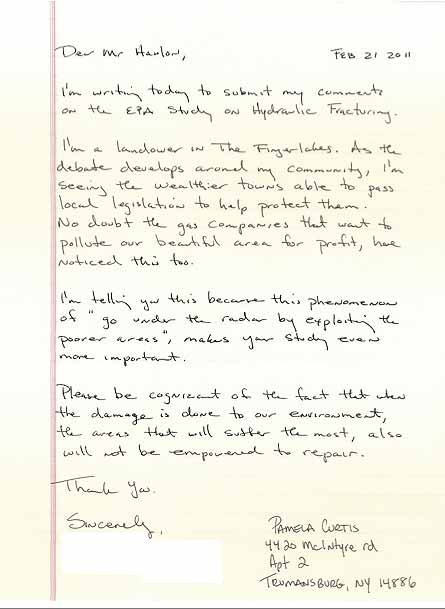
U.S. Environmental Protection Agency (EPA MOA). 2003. A Memorandum of Agreement Between The United States Environmental Protection Agency and BJ Services Company, Halliburton Energy Services, Inc., and Schlumberger Technology Corporation: Elimination of Diesel Fuel in Hydraulic Fracturing Fluids Injected into Underground Sources of Drinking Water During Hydraulic Fracturing of Coalbed Methane Wells, Dec. 12, 2003.
"While the Companies do not necessarily agree that hydraulic fracturing fluids using diesel fuel endanger USDWs when they are injected into CBM production wells, the Companies are prepared to enter into this agreement in response to EPA’s concerns and to reduce potential risks to the environment." See Drilling Around the Law for a follow-up on this voluntary agreement. According to the Environmental Working Group's report, "This promise, however, applied to only coalbed methane wells -- a small portion of natural gas and oil wells drilled – and only to those drilled directly into underground sources of drinking water."
Letter sent to the NYS Dept. of Environmental Conservation (NYSDEC) by the U.S. Environmental Protection Agency (EPA). Written in public response to the Draft Supplemental Environmental Impact Statement (dSGEIS). Dec. 30. 2009.
EPA believes that the analysis and discussion of cumulative and indirect impacts in the dSGEIS need to be significantly expanded. Even with its generic format, the dSGEIS should discuss the impacts that may result from past, present, and reasonably foreseeable future projects as well as those impacts associated with gas drilling and hydro fracturing that may occur later in time or at a distance from the immediate project site.
See: Walter Hang's Letter to DEC Commissioner Grannis Regarding Additional Natural Gas Hazards
The Safe Drinking Water Act (SDWA) is the main federal law that ensures the quality of Americans' drinking water. Under SDWA, EPA sets standards for drinking water quality and oversees the states, localities, and water suppliers who implement those standards.
SDWA was originally passed by Congress in 1974 to protect public health by regulating the nation's public drinking water supply.
The law was amended in 1986 and 1996 and requires many actions to protect drinking water and its sources: rivers, lakes, reservoirs, springs, and ground water wells. (SDWA does not regulate private wells which serve fewer than 25 individuals.)
Web Article contains links to legal, scientific, and contact information.
See: Safe Drinking Water Act 101 | Online Training | Drinking Water Academy
David Sternberg. 1/27/2010. "EPA Announces “Eyes on Drilling” Tipline".
The U.S. Environmental Protection Agency today announced the creation of the “Eyes on Drilling” tipline for citizens to report non-emergency suspicious activity related to oil and natural gas development.
The agency is asking citizens to call 1-877-919-4EPA (toll free) if they observe what appears to be illegal disposal of wastes or other suspicious activity.
Tip email address: eyesondrilling@epa.gov
Citizens may provide tips anonymously if they don’t want to identify themselves.
EPA's Mid-Atlantic Region has a natural gas drilling tip line for reporting dumping and other illegal or suspicious hauling and/or disposal activities.
Tip mailing address: EPA Region 3
1650 Arch Street (3CEOO)
Philadelphia, PA 19103-2029
In the event of an emergency, such as a spill or release of hazardous material, including oil, to the environment, citizens are advised to call the National Response Center at 1-800-424-8802.
Public concern about the environmental impacts of oil and natural gas drilling has increased in recent months, particularly regarding development of the Marcellus Shale formation where a significant amount of activity is occurring.
While EPA doesn’t grant permits for oil and gas drilling operations, there are EPA regulations which may apply to the storage of petroleum products and drilling fluids. The agency is also very concerned about the proper disposal of waste products, and protecting air and water resources.
See: Marcellus-Shale.us based in Pennsylvania, Photographs of fracking trucks.
Hydraulic fracturing is the injection of fluid under pressure to facilitate the production of oil and natural gas.
This page explains the process of hydraulic fracturing, how hydraulic fracturing is regulated, and EPA’s national 2010-2012 study on hydraulic fracturing of coalbed methane.
Weston Wilson Whistle Blower Letter
The U.S. Environmental Protection Agency (EPA) 2002 Study was crticized by EPA Whistle Blower Weston Wilson in this letter written to Senators Allard and Campbell and Representative DeGette. Denver, Colorado. October 8th, 2004.
See New York Times Editorial on Halliburton Loophole.
See also the Energy Policy Act of 2005.
U.S. EPA, 2002. Study to Evaluate the Impacts to the U.S. Drinking Water Supply (USDWs) by Hydraulic Fracturing of Coalbed Methane Reservoirs.
The study of coalbed methane (CBM) wells involved interviews with approximately 50 state and local government agency staff members, communications with about 40 citizens who were concerned that CBM production had adversely affected their drinking water wells, and searches for confirmed incidents of drinking water well contamination.
EPA published a draft report in August 2002, requested public comment, and incorporated changes as appropriate in Evaluation of Impacts to Underground Sources of Drinking Water by Hydraulic Fracturing of Coalbed Methane Reservoirs; National Study Final Report (2004)
The EPA's guidance led Congress to pass the 2005 Energy Policy Act that included the "Halliburton Loophole" of 2005. Exemption to EPA regulations for safe drinking water was granted for fracking in 2005.
"EPA has preliminarily found that the potential threats to public health posed by hydraulic fracturing of coalbed methane wells appear to be small and do not justify additional study. " (2002).
See: Hydraulic Fracturing Background Information
See: NYT Editorial: Questions About Fracturing
EPA's Current Hydraulic Fracturing Study (2010-2012)
In its Fiscal Year 2010 budget report, the U.S. House of Representatives Appropriation Conference Committee identified the need for a focused study of this topic. EPA agrees with Congress that there are serious concerns from citizens and their representatives about hydraulic fracturing’s potential impact on drinking water, human health and the environment, which demands further study.
More information on EPA's Hydraulic Fracturing Research Study.
Hydraulic Fracturing Research Study PDF (2pp, 343k)
See: Stakeholder Involvement Strategy
EPA Update. November 9-10 2010
On November 9, 2010, EPA announced that eight out of the nine hydraulic fracturing companies that received voluntary information requests in September agreed to submit timely and complete information to help the Agency conduct its study on hydraulic fracturing. However, the ninth company, Halliburton, has failed to provide EPA the information necessary to move forward with this important study. As a result, and as part of EPA's effort to move forward as quickly as possible, today EPA issued a subpoena to the company requiring submission of the requested information that has yet to be provided.
See: Letter sent by EPA to Halliburton PDF (2pp, 516K).
See: The subpoena sent by EPA to Halliburton PDF (11pp, 3.5M).
See: EPA Press Release on Results of Voluntary Information Request
See: Birth of EPA
Public Comments for Peer Review Panel Needed by November 22, 2010
On September 10, 2010, the Science Advisory Board (SAB) Staff Office posted a List of eighty-five Nominated Candidates for a Panel under the auspices of the SAB that will provide independent expert advice on EPA’s draft Hydraulic Fracturing Study Plan to investigate the potential public health and environmental protection research issues that may be associated with hydraulic fracturing. This List of Candidates is posted on the SAB Web Site. Public comments on this List of Candidates were received by October 1, 2010.
See: Natural Gas Drillers Protest Nomination of Fracking Critics for EPA Review Panel
See: Molly Ivins (2003). Bushwhacked : Life in George W. Bush's America

EPA regulates public water systems; it does not have the authority to regulate private drinking water wells. Approximately 15 percent of Americans rely on their own private drinking water supplies, and these supplies are not subject to EPA standards, although some state and local governments do set rules to protect users of these wells. Unlike public drinking water systems serving many people, they do not have experts regularly checking the water’s source and its quality before it is sent to the tap. These households must take special precautions to ensure the protection and maintenance of their drinking water supplies.
"...Check the paper or call your local planning or zoning commission for announcements about hearings or zoning appeals on development or industrial projects that could possibly affect your water.
Attend these hearings, ask questions about how your water source is being protected, and don't be satisfied with general answers. Make statements like "If you build this landfill, (just an example) what will you do to ensure that my water will be protected." See how quickly they answer and provide specifics about what plans have been made to specifically address that issue."
On March 18, 2010, The U.S. Environmental Protection Agency (EPA) announced that it will conduct a comprehensive research study to investigate the potential adverse impact that hydraulic fracturing may have on water quality and public health.
Natural gas plays a key role in our nation’s clean energy future and the process known as hydraulic fracturing is one way of accessing that vital resource.
There are concerns that hydraulic fracturing may impact ground water and surface water quality in ways that threaten human health and the environment.
EPA Scientific Advisory Board (SAB) Environmental Engineer Committee Hydraulic Fracturing Research Plan Review. 4/7/2010- 4/8/2010. The St Regis, 923 16th Street, NW, Washington DC 20006.
2011 EPA Hydraulic Fracturing Study Plan Review Panel Selections.
Disclaimer Although not required to do so, EPA generally posts public comments submitted to the SAB, Clean Air Science Advisory Committee (CASAC) or Council and their subcommittees on the internet to make them easily available to the public. Posting of public comments is not an Agency endorsement of, or agreement with, any information or viewpoints presented in the public comment, nor is it an Agency endorsement of the quality or correctness of such information and viewpoints. The SAB Staff intends to remove the public comments from the internet upon finalization of the pertinent advisory activity. Once removed, the comments may be obtained by contacting the Designated Federal Officer (DFO).
|
Edward Hanlon 202-343-9946 hanlon.edward@epa.gov |
|
Background Document- Evaluation Impacts to Underground Sources of DW by HF of Coalbed Methane Reservoirs. (PDF, 1 pp., 12,672 bytes) |
|
| Agency-provided Background Material | Background Document- Modern Shale Gas Development in the United States-A Primer. (PDF, 116 pp., 5,359,127 bytes) |
| Agency-provided Background Material | Background Document-Unconventional Gas Shales Development Technology and Policy Issues. (PDF, 53 pp., 2,546,992 bytes) |
| Agency Briefing Material | EPA Presentation Materials, 4-6-10. (PDF, 22 pp., 776,783 bytes) |
| Charge to the Committee | Charge Questions - Advice on Hydraulic Fracturing Research . (PDF, 3 pp., 45,693 bytes) |
| Public Comments | List of Public Speakers-Hydraulic Fracturing April 2010 Meeting as of 4-6-10. (PDF, 1 pp., 17,113 bytes) |
| Public Comments | Oral Statement Submitted by Chad Bradley, Representing Chesapeake Energy Corporation, 4-7-10. (PDF, 4 pp., 1,350,622 bytes) |
| Public Comments | Oral Statement Submitted by Craig Segall, Representing Sierra Club, 4-5-10. (PDF, 5 pp., 81,937 bytes) |
| Public Comments | Oral Statement Submitted by Jennifer Peters, Representing Clean Water Network, 4-6-10. (PDF, 3 pp., 124,334 bytes) |
| Public Comments | Oral Statement Submitted by Keith Hastie, Representing US Fish and Wildlife Service, 4-7-10. (PDF, 2 pp., 433,041 bytes) |
| Public Comments | Oral Statement Submitted by Lauren Pagel, Representing EARTHWORKS, 4-7-10. (PDF, 2 pp., 17,787 bytes) |
| Public Comments | Oral Statement Submitted by Mary Krueger, Representing The Wilderness Society, 4-6-10. (PDF, 3 pp., 75,525 bytes) |
| Public Comments | Oral Statement Submitted by Mike Watts, Representing Halliburton Energy Services Inc., 4-6-10. (PDF, 6 pp., 72,197 bytes) |
| Public Comments | Oral Statement Submitted by Mr. Lee Fuller, Representing Independent Petroleum Association of America (IPAA) and Energy In Depth (EID), 3-28-10. (PDF, 3 pp., 46,255 bytes) |
| Public Comments | Oral Statement submitted by Mr. Richard Liroff, representing Investor Environmental Health Network, 3-26-10. (PDF, 6 pp., 85,739 bytes) |
| Public Comments | Oral Statement Submitted by Stephanie R. Meadows, Representing American Petroleum Institute, 4-6-10. (PDF, 5 pp., 26,559 bytes) |
| Public Comments | Presentation by Craig Segall, Representing Sierra Club, 4-5-10. (PDF, 9 pp., 333,895 bytes) |
| Public Comments | Presentation Submitted by Mary Krueger, Representing The Wilderness Society, 4-6-10. (PDF, 3 pp., 2,008,663 bytes) |
| Public Comments | Public Comments Submitted by Beth Pierce, 4-6-10. (PDF, 2 pp., 11,822 bytes) |
| Public Comments | Public Comments Submitted by Bill Podulka, 4-6-10. (PDF, 3 pp., 27,229 bytes) |
| Public Comments | Public Comments Submitted by David and Ginny Farmer, Dryden, NY, 4-6-10. (PDF, 1 pp., 8,764 bytes) |
| Public Comments | Public Comments Submitted by Debra Anderson, Representing Red Rock Pictures, 4-6-10. (PDF, 2 pp., 12,177 bytes) |
| Public Comments | Public Comments Submitted by Ellen Schmidt, Ithaca, New York, 4-5-10. (PDF, 1 pp., 8,462 bytes) |
| Public Comments | Public Comments Submitted by Fernando de Aragón, Representing Ithaca-Tompkins County Transportation Council, 4-5-10. (PDF, 4 pp., 65,781 bytes) |
| Public Comments | Public Comments Submitted by Frances Littin, Representing Sheldrake Point Winery, 4-6-10. (PDF, 1 pp., 400,153 bytes) |
| Public Comments | Public Comments Submitted by Harry Levine, representing Advocates for Springfield, 4-7-10. (PDF, 2 pp., 11,361 bytes) |
| Public Comments | Public Comments Submitted by Honorable Brad Henry, Governor of the State of Oklahoma, 3-25-10. (PDF, 1 pp., 58,570 bytes) |
| Public Comments | Public Comments Submitted by Hugh Kimball, Baldwinsville NY, 4-5-10. (PDF, 1 pp., 10,603 bytes) |
| Public Comments | Public Comments Submitted by Jan Zeserson, Ithaca, New York, 4-5-10. (PDF, 1 pp., 11,494 bytes) |
| Public Comments | Public Comments Submitted by Jill Wiener, Callicoon Center NY, 4-6-10. (PDF, 3 pp., 20,347 bytes) |
| Public Comments | Public Comments Submitted by Joe Wilson, Ithaca, NY, 4-5-10. (PDF, 5 pp., 47,843 bytes) |
| Public Comments | Public Comments Submitted by Kari Matsko, Representing Northeast Ohio Gas Accountability Project-NEOGAP, 4-6-10. (PDF, 13 pp., 746,003 bytes) |
| Public Comments | Public Comments Submitted by Karl Seeley, Representing Hartwick College, 4-5-10. (PDF, 1 pp., 9,090 bytes) |
| Public Comments | Public Comments Submitted by Ken Zeserson, Representing Town of Ulysses New York Planning Board, 4-5-10. (PDF, 50 pp., 567,832 bytes) |
| Public Comments | Public Comments Submitted by Kirk Glundal, Representing EarthEmbers, 4-6-10. (PDF, 1 pp., 8,789 bytes) |
| Public Comments | Public Comments Submitted by Marge Hubbert, Cortland New York, 4-5-10. (PDF, 1 pp., 11,935 bytes) |
| Public Comments | Public Comments Submitted by Marilyn Hunt, 4-6-10. (PDF, 7 pp., 374,498 bytes) |
| Public Comments | Public Comments Submitted by Marilyn Hunt, 4-7-10. (PDF, 1 pp., 8,519 bytes) |
| Public Comments | Public Comments Submitted by Mark Dunau, Representing Northeast Organic Farming Association of New York, and Delaware County Farm Bureau of New York, 4-7-10. (PDF, 3 pp., 25,930 bytes) |
| Public Comments | Public Comments Submitted by Martha Robertson, Representing Tompkins County Legislature, 4-5-10. (PDF, 4 pp., 98,977 bytes) |
| Public Comments | Public Comments Submitted by Martha Robertson, Representing Tompkins County Legislature, 4-8-10. (PDF, 8 pp., 211,284 bytes) |
| Public Comments | Public Comments Submitted by Michael P. Crall, Representing U.S. Army Corps of Engineers Pittsburgh District, 3-26-10. (PDF, 14 pp., 4,216,085 bytes) |
| Public Comments | Public Comments Submitted by Michael Scarna, Representing Trybe Inc., 4-6-10. (PDF, 2 pp., 106,094 bytes) |
| Public Comments | Public Comments Submitted by Michelle Bamberger, Representing Vet Behavior Consults, 4-6-10. (PDF, 2 pp., 15,088 bytes) |
| Public Comments | Public Comments Submitted by Mr. Ben Wallace, Representing Penneco Oil Company, 3-26-10. (PDF, 6 pp., 2,175,822 bytes) |
| Public Comments | Public Comments Submitted by Mr. Bob Bemis Representing Noble Energy, Inc., 3-29-10. (PDF, 4 pp., 51,412 bytes) |
| Public Comments | Public Comments Submitted by Mr. Bob Flournoy, Representing Energy Investment Partners-3-24-10. (PDF, 1 pp., 9,637 bytes) |
| Public Comments | Public Comments Submitted by Mr. Caswell F. Holloway, Representing New York City Department of Environmental Protection, 3-31-10. (PDF, 1 pp., 780,578 bytes) |
| Public Comments | Public Comments submitted by Mr. D. Gerow Baker, representing Interstate Oil and Gas Compact Commission-3-26-10. (PDF, pp., 2,957,003 bytes) |
| Public Comments | Public Comments submitted by Mr. Edwin P. Przybylowicz, Representing Seneca Lake Pure Waters Association, 3-27-10. (PDF, 15 pp., 2,524,294 bytes) |
| Public Comments | Public Comments Submitted by Mr. Gregory D. Russell, Representing the Ohio Oil and Gas Association, 3-29-10. (PDF, 7 pp., 1,394,322 bytes) |
| Public Comments | Public Comments Submitted by Mr. James F. Barre, Representing Keuka Lake Association, 3-29-10. (PDF, 2 pp., 18,257 bytes) |
| Public Comments | Public Comments Submitted by Mr. Jeff Zimmerman, Representing Damascus Citizens for Sustainability and Friends of the Upper Delaware River, 3-29-10. (PDF, 3 pp., 75,495 bytes) |
| Public Comments | Public Comments Submitted by Mr. Keith Curley, Representing Trout Unlimited, 3-29-10. (PDF, 1 pp., 194,585 bytes) |
| Public Comments | Public Comments Submitted by Mr. Mike Paque, representing Ground Water Protection Council, 3-26-10. (PDF, 1 pp., 32,007 bytes) |
| Public Comments | Public Comments Submitted by Mr. Robert Neid, Representing Schoharie Valley Watch, 4-2-10. (PDF, 1 pp., 9,536 bytes) |
| Public Comments | Public Comments Submitted by Mr. Steve Coffman, Representing Committee to Preserve the Finger Lakes, 3-26-10. (PDF, 4 pp., 23,286 bytes) |
| Public Comments | Public Comments Submitted by Mr. William Wegner, Representing Riverkeeper, Inc., 3-29-10. (PDF, 25 pp., 1,787,077 bytes) |
| Public Comments | Public Comments Submitted by Ms. Katherine Klaber, Representing Marcellus Shale Coalition, 3-29-10. (PDF, 3 pp., 97,101 bytes) |
| Public Comments | Public Comments Submitted by Ms. Kathleen M. Sgamma, Representing Independent Petroleum Association of Mountain States (IPAMS), 3-29-10. (PDF, 7 pp., 344,892 bytes) |
| Public Comments | Public Comments Submitted by Ms. Natalie Roy, Representing Clean Water Network, 3-29-10. (PDF, 6 pp., 120,366 bytes) |
| Public Comments | Public Comments Submitted by Oskar Schmidt, Ithaca, New York, 4-5-10. (PDF, 1 pp., 9,210 bytes) |
| Public Comments | Public Comments Submitted by Ramsay Adams, Representing Catskill Mountainkeeper, 4-6-10. (PDF, 4 pp., 23,009 bytes) |
| Public Comments | Public Comments Submitted by Ronald E. Bishop, Cooperstown, NY, 4-7-10. (PDF, 1 pp., 9,795 bytes) |
| Public Comments | Public Comments Submitted by Sandy Podulka, Brooktondale, NY, 4-7-10. (PDF, 9 pp., 59,415 bytes) |
| Public Comments | Public Comments Submitted by Sarah Gowin, Ithaca, New York, 4-5-10. (PDF, 1 pp., 12,707 bytes) |
| Public Comments | Public Comments Submitted by Scott M. Stringer, Representing Manhatten Borough, New York City, NY, 4-7-10. (PDF, 12 pp., 839,399 bytes) |
| Public Comments | Public Comments Submitted by Secretary of Energy Robert Wegener and Secretary of Environment J.D. Strong of the State of Oklahoma, 3-26-10. (PDF, 4 pp., 246,855 bytes) |
| Public Comments | Public Comments Submitted by Stephen L Dungan, Walton, NY, 4-5-10. (PDF, 2 pp., 15,423 bytes) |
| Public Comments | Public Comments Submitted by Stephen Penningroth, Ithaca, NY, 4-7-10. (PDF, 16 pp., 92,429 bytes) |
| Public Comments | Public Comments Submitted by Stuart Kemp, Representing Halliburton Energy Services Inc., 4-6-10. (PDF, 16 pp., 244,179 bytes) |
| Public Comments | Public Comments Submitted by Talia Lugacy, Hancock, NY, 4-6-10. (PDF, 3 pp., 131,129 bytes) |
| Public Comments | Public Comments Submitted byTom Noonan, Hancock, NY, 4-6-10. (PDF, 3 pp., 76,172 bytes) |
Americans depend on clean and abundant water. However, over the past decade, interpretations of Supreme Court rulings removed some critical waters from Federal protection, and caused confusion about which waters and wetlands are protected under the Clean Water Act. As a result, important waters now lack clear protection under the law, and businesses and regulators face uncertainty and delay. The Obama Administration is committed to protecting waters on which the health of people, the economy and ecosystems depend.
U.S. EPA and the U.S. Army Corps of Engineers have developed draft guidance for determining whether a waterway, water body, or wetland is protected by the Clean Water Act. This guidance would replace previous guidance to reaffirm protection for critical waters. It also will provide clearer, more predictable guidelines for determining which water bodies are protected by the Clean Water Act. The draft guidance will be open for 60 days of public comment to allow all stakeholders to provide input and feedback before it is finalized.
The draft guidance will reaffirm protections for small streams that feed into larger streams, rivers, bays and coastal waters. It will also reaffirm protection for wetlands that filter pollution and help protect communities from flooding. Discharging pollution into protected waters (e.g., dumping sewage, contaminants, or industrial pollution) or filling protected waters and wetlands (e.g., building a housing development or a parking lot) require permits. This guidance will keep safe the streams and wetlands that affect the quality of the water used for drinking, swimming, fishing, farming, manufacturing, tourism and other activities essential to the American economy and quality of life. It also will provide regulatory clarity, predictability, consistency and transparency.
See: William Ringler sentenced to prison of Clean Water Act violation
See: Supreme Court Restricts Clean Water Act
 EPA's Draft Hydraulic Fracturing Study Plan
EPA's Draft Hydraulic Fracturing Study Plan
 Science Advisory Board Public Comments Letters from the Public. March 7, 2011. Posted to Web.
Science Advisory Board Public Comments Letters from the Public. March 7, 2011. Posted to Web.
You can read all the form letters submitted from Texas, as well as my letter here:
| Public comment submitted to the SAB Staff Office | Public Comments submitted by Neil Zusman, Ithaca, NY-2-28-11. (PDF, 3 pp., 118,694 bytes) |
"The States have not shown that they can adequately regulate gas drilling, especially in more populated areas. Federal Regulations are clearly needed.
Time and time again, as noted by a Pew Research Group report, a wide variety of industries, in seat belts, lead paint, cigarettes and many others, have fought federal regulation only to have history prove that it never hurt their bottom line." (Neil Zusman, 2011-02-28).
See: Pew Environment Group (PEG) Factsheet: Industry Opposition to Government Regulation (PDF), October 14, 2010.
See: Letter from Thomas Curtis, AWW. Website below:
In summary, AWWA supports protecting of sources of drinking water under any and all circumstances, including hydraulic fracturing. We appreciate the agency’s consideration of our comments. If there are any questions about these comments, please direct them to Alan Roberson, AWWA, at (202) 326-6127.
Yours Sincerely,
Thomas W. Curtis Deputy Executive Director
See this hand-written letter by Pamela Curtis of Trumansburg, New York:
See: Federal Register: Science Advisory Board Staff Office; Notification of a Public Meeting of the Science Advisory Board Panel for the Review of EPA's Hydraulic Fracturing Study Plan. EPA Notice: 2/09/11.
The Environmental Protection Agency (EPA or Agency) Science Advisory Board (SAB) Staff Office announces a public face-to-face meeting of the SAB Panel to conduct an independent review of EPA's Draft Hydraulic Fracturing Study Plan.
The meeting will be held on March 7, 2011 from 9 a.m. to 5 p.m., and March 8, 2011 from 8 a.m. to 5 p.m. (Eastern Time).
The Panel meeting will be held at the Westin Alexandria Hotel located at 400 Courthouse Square, Alexandria, VA 22314.
Members of the public can submit comments for a federal advisory committee to consider as it develops advice for EPA. They should send their comments directly to the Designated Federal Officer for the relevant advisory committee.
Oral Statements: In general, individuals or groups requesting an oral presentation at this public meeting will be limited to five minutes per speaker. Interested parties should contact Mr. Edward Hanlon, DFO, in writing (preferably via e-mail), at the contact information noted above, by February 28, 2011 to be placed on the list of public speakers for the meeting.
Written Statements:
Written statements should be received in the SAB Staff Office by February 28, 2011 so that the information may be made available to the SAB Hydraulic Fracturing Study Plan Review Panel for their consideration.
In its Fiscal Year 2010 budget report, the U.S. House of Representatives Appropriation Conference Committee identified the need for a focused study of this topic. EPA scientists, under this administration and at the direction of Congress, are undertaking a study of this practice to better understand any potential impacts of hydraulic fracturing on drinking water and groundwater. EPA consulted with experts in the field through peer review, and technical workshops and engaged stakeholders in a dialogue about the study through facilitated public meetings.
EPA has submitted its draft study plan on hydraulic fracturing for review to the agency's Science Advisory Board (SAB).
The overall purpose of the study is to understand the relationship between hydraulic fracturing and drinking water resources. The scope of the proposed research includes the full lifespan of water in hydraulic fracturing, from acquisition of the water, through the mixing of chemicals and actual fracturing, to the post-fracturing stage, including the management of flowback and produced water and its ultimate treatment and disposal.
The SAB plans to review the draft plan March 7-8, 2011. Consistent with the operating procedures of the SAB, an opportunity will be provided for stakeholders and the public to provide comments to the SAB during their review. The Agency will revise the study plan in response to the SAB's comments and promptly begin the study. Initial research results are expected by the end of 2012 with a goal for a report in 2014.
See: Industry responds to public take on hydraulic fracturing | Fracking Resource Guide
See: EPA Hydraulic Fracturing Study Plan Review Panel
See: Lisa P. Jackson, EPA (lisapjackson) on Twitter
See: U.S. Congress. Committee on Space, Science, and Technology. "Hearing Highlights Lack of Objectivity in Draft EPA Fracking Study--No Evidence of Drinking Water Contamination from Fracking, Witnesses Say". May 11, 2011
Hydraulic Fracturing Study Plan Review Panel
The Panel will review and provide independent expert advice on EPA’s draft Hydraulic Fracturing Study Plan that will investigate the potential public health and environmental protection research issues that may be associated with hydraulic fracturing.
It will be led by David A. Dzombak, professor of environmental engineering at Carnegie Mellon University.
Legere, Laura. "Peer-review panel for EPA fracking study includes six Pa. scientists." The Scranton Times-Tribune. Jan. 18, 2011.
A panel of geologists, toxicologists, engineers and doctors that will peer-review a high-profile Environmental Protection Agency study of hydraulic fracturing will include six scientists from Pennsylvania, more than any other state.
The panel will review the techniques and analysis the EPA uses to draft a study of the potential environmental and health impacts of hydraulic fracturing - the process used in natural gas exploration of injecting a high-pressure mix of chemically treated water and sand underground to break apart a rock formation and release the gas.
...In a memo announcing the new panel, the EPA found "no conflicts of interest or appearances of a lack of impartiality for the members of this panel."
See: Natural Gas Drillers Protest Nomination of Fracking Critics for EPA Review Panel
See also: Hydraulic Fracturing Study Plan
Determination Memo:
Posted 01/13/2011
Determination Memo for this Activity. (1/27/2011, PDF, 11 pp., 44,581 bytes)
Members:
| Dzombak, David A. | Chair | Carnegie Mellon University | Pittsburgh | PA |
| Alexeeff, George | California Environmental Protection Agency | Oakland | CA | |
| Ballestero, Tom | University of New Hampshire | Durham | NH | |
| Benjamin, Mark | University of Washington | Seattle | WA | |
| Boufadel, Michel | Temple University | Philadelphia | PA | |
| Boyer, Elizabeth | Pennsylvania State University | University Park | PA | |
| Burnett, David | Texas A&M University | College Station | TX | |
| Davis, Thomas L. | Colorado School of Mines | Golden | CO | |
| Dunn-Norman, Shari | Missouri University of Science and Technology | Rolla | MO | |
| Giesy, John P. | University of Saskatchewan | Saskatoon | Saskatchewan | |
| Griffiths, Jeffrey | Tufts University | Boston | MA | |
| Gschwend, Phillip | Massachusetts Institute of Technology | Cambridge | MA | |
| Harris, Cynthia M. | Florida A&M University | Tallahassee | FL | |
| Kim, Nancy K. | Health Research, Inc. | Troy | NY | |
| Lee, Cindy M. | Clemson University | Anderson | SC | |
| Patten, Duncan | Montana State University | Bozeman | MT | |
| Randtke, Stephen | University of Kansas | Lawrence | KS | |
| Reible, Danny | University of Texas | Austin | TX | |
| Schreppel, Connie | Mohawk Valley Water Authority | Utica | NY | |
| Thyne, Geoffery | University of Wyoming | Laramie | WY | |
| VanBriesen, Jeanne | Carnegie Mellon University | Pittsburgh | PA | |
| Vidic, Radisav | University of Pittsburgh | Pittsburgh | PA |













